Related Research Articles

Stomach cancer, also known as gastric cancer, is a cancer that develops from the lining of the stomach. Most cases of stomach cancers are gastric carcinomas, which can be divided into a number of subtypes, including gastric adenocarcinomas. Lymphomas and mesenchymal tumors may also develop in the stomach. Early symptoms may include heartburn, upper abdominal pain, nausea, and loss of appetite. Later signs and symptoms may include weight loss, yellowing of the skin and whites of the eyes, vomiting, difficulty swallowing, and blood in the stool, among others. The cancer may spread from the stomach to other parts of the body, particularly the liver, lungs, bones, lining of the abdomen, and lymph nodes.

Li–Fraumeni syndrome is a rare, autosomal dominant, hereditary disorder that predisposes carriers to cancer development. It was named after two American physicians, Frederick Pei Li and Joseph F. Fraumeni Jr., who first recognized the syndrome after reviewing the medical records and death certificates of 648 childhood rhabdomyosarcoma patients. This syndrome is also known as the sarcoma, breast, leukaemia and adrenal gland (SBLA) syndrome.

Linitis plastica is a morphological variant of diffuse stomach cancer in which the stomach wall becomes thick and rigid.

Cadherins (named for "calcium-dependent adhesion") are cell adhesion molecules important in forming adherens junctions that let cells adhere to each other. Cadherins are a class of type-1 transmembrane proteins, and they depend on calcium (Ca2+) ions to function, hence their name. Cell-cell adhesion is mediated by extracellular cadherin domains, whereas the intracellular cytoplasmic tail associates with numerous adaptors and signaling proteins, collectively referred to as the cadherin adhesome.

Hereditary nonpolyposis colorectal cancer (HNPCC) is a hereditary predisposition to colon cancer.

A paraganglioma is a rare neuroendocrine neoplasm that may develop at various body sites. When the same type of tumor is found in the adrenal gland, they are referred to as a pheochromocytoma. They are rare tumors, with an overall estimated incidence of 1 in 300,000. There is no test that determines benign from malignant tumors; long-term follow-up is therefore recommended for all individuals with paraganglioma.
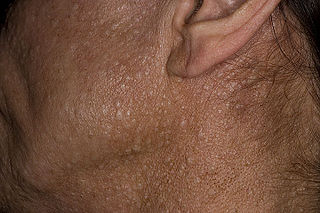
Birt–Hogg–Dubé syndrome (BHD), also Hornstein–Birt–Hogg–Dubé syndrome, Hornstein–Knickenberg syndrome, and fibrofolliculomas with trichodiscomas and acrochordons is a human, adult onset, autosomal dominant genetic disorder caused by a mutation in the folliculin (FLCN) gene. It can cause susceptibility to kidney cancer, renal and pulmonary cysts, and noncancerous tumors of the hair follicles, called fibrofolliculomas. The symptoms seen in each family are unique, and can include any combination of the three symptoms. Fibrofolliculomas are the most common manifestation, found on the face and upper trunk in over 80% of people with BHD over the age of 40. Pulmonary cysts are equally common (84%) and 24% of people with BHD eventually experience a collapsed lung. Kidney tumors, both cancerous and benign, occur in 14–34% of people with BHD; the associated kidney cancers are often rare hybrid tumors.

Cowden syndrome is an autosomal dominant inherited condition characterized by benign overgrowths called hamartomas as well as an increased lifetime risk of breast, thyroid, uterine, and other cancers. It is often underdiagnosed due to variability in disease presentation, but 99% of patients report mucocutaneous symptoms by age 20–29. Despite some considering it a primarily dermatologic condition, Cowden's syndrome is a multi-system disorder that also includes neurodevelopmental disorders such as macrocephaly.

Hereditary breast–ovarian cancer syndromes (HBOC) are cancer syndromes that produce higher than normal levels of breast cancer, ovarian cancer and additional cancers in genetically related families. It accounts for 90% of the hereditary cancers. The hereditary factors may be proven or suspected to cause the pattern of breast and ovarian cancer occurrences in the family. The name HBOC may be misleading because it implies that this genetic susceptibility to cancer is mainly in women. In reality, both sexes have the same rates of gene mutations and HBOC can predispose to other cancers including prostate cancer and pancreatic cancer. For this reason, the term "King syndrome" has recently come into use. The new name references Mary-Claire King who identified the genes BRCA1 and BRCA2.
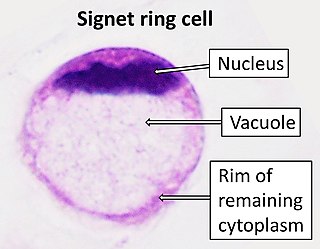
Signet ring cell carcinoma (SRCC) is a rare form of highly malignant adenocarcinoma that produces mucin. It is an epithelial malignancy characterized by the histologic appearance of signet ring cells.

Cadherin-1 or Epithelial cadherin(E-cadherin), is a protein that in humans is encoded by the CDH1 gene. Mutations are correlated with gastric, breast, colorectal, thyroid, and ovarian cancers. CDH1 has also been designated as CD324. It is a tumor suppressor gene.

Lobular carcinoma in situ (LCIS) is an incidental microscopic finding with characteristic cellular morphology and multifocal tissue patterns. The condition is a laboratory diagnosis and refers to unusual cells in the lobules of the breast. The lobules and acini of the terminal duct-lobular unit (TDLU), the basic functional unit of the breast, may become distorted and undergo expansion due to the abnormal proliferation of cells comprising the structure. These changes represent a spectrum of atypical epithelial lesions that are broadly referred to as lobular neoplasia (LN).
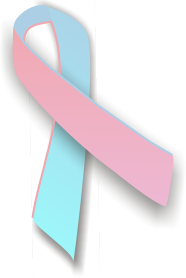
Male breast cancer (MBC) is a cancer in males that originates in their breasts. Males account for less than 1% of new breast cancers with about 20,000 new cases being diagnosed worldwide every year. Its incidence rates in males vs. females are, respectively, 0.4 and 66.7 per 100,000 person-years. The worldwide incidences of male as well as female breast cancers have been increasing over the last few decades. Currently, one of every 800 men are estimated to develop this cancer during their lifetimes.

Invasive lobular carcinoma (ILC) is breast cancer arising from the lobules of the mammary glands. It accounts for 5–10% of invasive breast cancer. Rare cases of this carcinoma have been diagnosed in men.

A BRCA mutation is a mutation in either of the BRCA1 and BRCA2 genes, which are tumour suppressor genes. Hundreds of different types of mutations in these genes have been identified, some of which have been determined to be harmful, while others have no proven impact. Harmful mutations in these genes may produce a hereditary breast–ovarian cancer syndrome in affected persons. Only 5–10% of breast cancer cases in women are attributed to BRCA1 and BRCA2 mutations, but the impact on women with the gene mutation is more profound. Women with harmful mutations in either BRCA1 or BRCA2 have a risk of breast cancer that is about five times the normal risk, and a risk of ovarian cancer that is about ten to thirty times normal. The risk of breast and ovarian cancer is higher for women with a high-risk BRCA1 mutation than with a BRCA2 mutation. Having a high-risk mutation does not guarantee that the woman will develop any type of cancer, or imply that any cancer that appears was actually caused by the mutation, rather than some other factor.
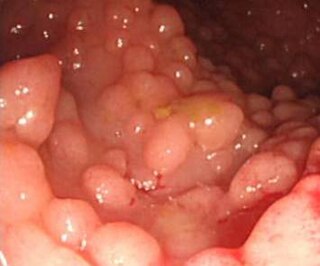
A hereditary cancer syndrome is a genetic disorder in which inherited genetic mutations in one or more genes predispose the affected individuals to the development of cancer and may also cause early onset of these cancers. Hereditary cancer syndromes often show not only a high lifetime risk of developing cancer, but also the development of multiple independent primary tumors.
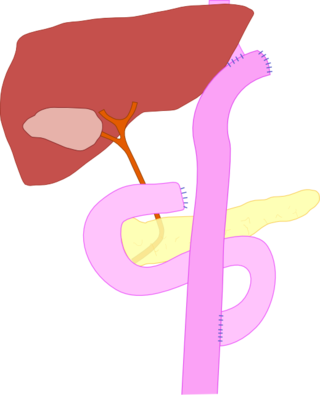
Hereditary diffuse gastric cancer (HDGC) is an inherited genetic syndrome most often caused by an inactivating mutation in the E-cadherin gene (CDH1) located on chromosome 16. Individuals who inherit an inactive copy of the CDH1 gene are at significantly elevated risk for developing stomach cancer. For this reason, individuals with these mutations will often elect to undergo prophylactic gastrectomy, or a complete removal of the stomach to prevent this cancer. Mutations in CDH1 are also associated with high risk of lobular breast cancers, and may be associated with a mildly elevated risk of colon cancer.
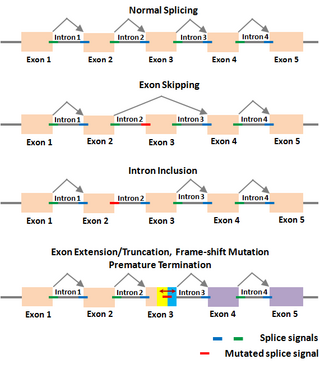
The Shapiro—Senapathy algorithm (S&S) is an algorithm for predicting splice junctions in genes of animals and plants. This algorithm has been used to discover disease-causing splice site mutations and cryptic splice sites.
Papillomatosis of the breast (PB) is a rare, benign, epitheliosis-like lesion, i.e. an overgrowth of the cells lining the ducts of glands that resembles a papilla or nipple-like nodule/tumor. PB tumors develop in the apocrine glands of the breast. PB is also termed juvenile papillomatosis because of its frequent occurrence in younger women and Swiss cheese disease because of its microscopic appearance. Rarely, PB has also been diagnosed in very young, adolescent, and adult males.
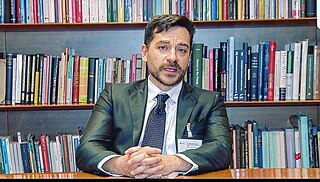
Giovanni Corso is an Italian academic and surgeon. He is a Senior Researcher at University of Milan. Corso is the current president of the European Cancer Prevention Organization and the editor-in-chief of the European Journal of Cancer Prevention. His main research activities are on hereditary diffuse gastric cancer and hereditary lobular breast cancer associated with Cadherins disfunction.
References
- ↑ Corso, Giovanni (2018). "Hereditary lobular breast cancer with an emphasis on E-cadherin genetic defect". Journal of Medical Genetics. 55 (7): 431–441. doi:10.1136/jmedgenet-2018-105337. PMID 29929997. S2CID 206998695.
- ↑ Blair, Vanessa (2020). "Hereditary diffuse gastric cancer: updated clinical practice guidelines". Lancet Oncology. 21 (8): e386–e397. doi:10.1016/S1470-2045(20)30219-9. PMC 7116190 . PMID 32758476.
- ↑ Asif, Bilal; Sarvestani, Amber Leila; Gamble, Lauren A.; Samaranayake, Sarah G.; Famiglietti, Amber L.; Fasaye, Grace-Ann; Quezado, Martha; Miettinen, Markku; Korman, Louis; Koh, Christopher; Heller, Theo; Davis, Jeremy L. (April 25, 2023). "Cancer surveillance as an alternative to prophylactic total gastrectomy in hereditary diffuse gastric cancer: a prospective cohort study". The Lancet. Oncology. 24 (4): 383–391. doi:10.1016/S1470-2045(23)00057-8. PMC 10084814 . PMID 36990610.
- ↑ Garcia-Pelaez, José; Barbosa-Matos, Rita; Lobo, Silvana; Dias, Alexandre; Garrido, Luzia; Castedo, Sérgio; Sousa, Sónia; Pinheiro, Hugo; Sousa, Liliana; Monteiro, Rita; Maqueda, Joaquin J.; Fernandes, Susana; Carneiro, Fátima; Pinto, Nádia; Lemos, Carolina (January 2023). "Genotype-first approach to identify associations between CDH1 germline variants and cancer phenotypes: a multicentre study by the European Reference Network on Genetic Tumour Risk Syndromes". The Lancet. Oncology. 24 (1): 91–106. doi:10.1016/S1470-2045(22)00643-X. ISSN 1474-5488. PMC 9810541 . PMID 36436516.
- ↑ Corso, Giovanni (2020). "E-cadherin deregulation in breast cancer". Journal of Cellular and Molecular Medicine. 24 (11): 5930–5936. doi: 10.1111/jcmm.15140 . PMC 7294130 . PMID 32301282.
- ↑ Understanding How CDH1 Germline Mutations Affect Hereditary Lobular Breast Cancer, European Institute of Oncology, 2021-02-11, archived from the original on 2021-04-23, retrieved 2021-04-23– via clinicaltrials.gov
- ↑ Gamble, Lauren A.; McClelland, Paul H.; Teke, Martha E.; Samaranayake, Sarah G.; Juneau, Paul; Famiglietti, Amber L.; Blakely, Andrew M.; Redd, Bernadette; Davis, Jeremy L. (September 27, 2023). "Defining features of hereditary lobular breast cancer due to CDH1 with magnetic resonance imaging and tumor characteristics". npj Breast Cancer. 9 (1): 77. doi:10.1038/s41523-023-00585-4. PMC 10533560 . PMID 37758801.